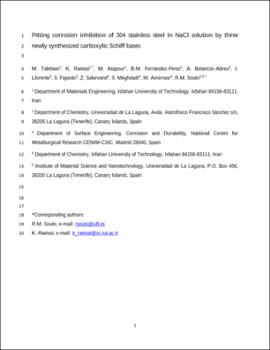Synthesis and evaluation of three new anionic Schiff bases as pitting corrosion inhibitor for stainless steel 304 in NaCl solution
Date
2019Abstract
Three newly synthesized Schiff base derivatives, sodium (E)-4-(nitrobenzylideneamino)-benzoate (SNBB), sodium (E)-4-(benzylideneamino)-benzoate (SBB), and sodium (E)-4-(hydroxybenzylideneamino)-benzoate (SHBB) were investigated as pitting corrosion inhibitors for 304 stainless steel in neutral 0.1 M NaCl. Potentiodynamic polarization evidenced major shifts in pitting potential to more positive values with increasing inhibitor concentration. The scanning vibrating electrode technique (SVET) imaged metastable pitting in 0.1 M NaCl, but not in the presence of the inhibitor, indicating that it prevented pit nucleation. The inhibition performance was established under anodic polarization conditions, because only minute local anodic activity due to metastable pit formation could be observed when the steel was exposed to SNBB-containing solution, whereas the metal would undergo pit propagation at the same potential in the inhibitor-free solution. X-ray photoelectron spectroscopy (XPS) analysis evidenced chromium enrichment at weak points (pores) of the passive film at anodic polarization condition where sudden release of Fe cations is possible. In this way, the SNBB molecules will migrate to these sites to react with the Fe ions and form a chelate compound which will deposit finally at those sites and plug them, whereas no effect occurred at the open circuit potential (OCP)






